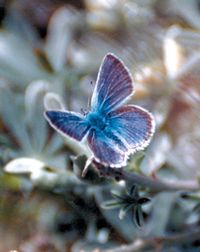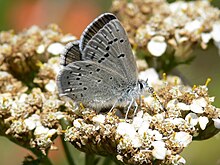Mission blue butterfly
| Mission blue butterfly | |
|---|---|
 |
|
 |
|
| Scientific classification | |
| Kingdom: | Animalia |
| Phylum: | Arthropoda |
| Class: | Insecta |
| Order: | Lepidoptera |
| Family: | Lycaenidae |
| Tribe: | Polyommatini |
| Genus: | Aricia |
| Species: | A. icarioides |
| Subspecies: | A. icarioides missionensis |
| Trinomial name | |
|
Aricia icarioides missionensis (Hovanitz, 1937) |
|
| Synonyms | |
|
|
The Mission blue (Aricia icarioides missionensis) is a blue or lycaenid butterfly subspecies native to the San Francisco Bay Area of the United States. The butterfly has been declared as endangered by the US federal government. It is a subspecies of Boisduval's blue (Aricia icarioides).
The endangered Mission blue has a wingspan around 21–33 millimetres (0.83–1.3 in). Larvae are extremely small and rarely seen. The males' top wing grades from ice blue in the center to deep sky blue (misregistered as turquoise/cyan to violet by most photographic equipment, the wing color carries no hint of green or purple, strictly capturing an enthralling spectrum of purest, clearest, richest, brightest blue) exhibiting a dazzling iridescent fluctuation in range under direct, full sunlight. Black margins on the upper wing sport "long, white, hair-like scales". A constellation of jet-black dots (misregistered as dull gray by most photographic equipment) frames the extremities of the ventral surface, its pattern adroitly complimenting the wing shape thrown into spectacular relief against the shimmering silvery pearlescent background, with a fascinatingly muted hint of dark ice blue bleeding faintly up from the body and permeating the veins throughout for the palest, most delicate of emphases. Body shape, eyes, antennae, and appendages possess it of a uniquely exquisite poise. The males' bodies are dark-blue/brown. Females' upper wings are dark brown, but otherwise mirror males'.
The larvae only feed on the leaves of the three host lupine plants (Lupinus albifrons, Lupinus formosus, and Lupinus variicolor) native to their habitat. The plants are necessary for survival for the Mission blue. Thus, the butterfly's fate is closely tied to that of the three species of lupines as the plants provide food and shelter for the butterfly in its larval stage. The adult Mission blue drinks the nectar of a variety of flowers, many in the sunflower family, using its long proboscis which extends from the underside of its head.
P. i. missionensis is federally endangered and found in only a few locations. Its habitat is restricted to the San Francisco Bay Area, specifically six areas, the Twin Peaks area in San Francisco County, Fort Baker, a former military installation managed by the National Park Service (NPS), in Marin County, the San Bruno Mountain area in San Mateo County, the Marin Headlands, in Golden Gate National Recreation Area (another NPS entity), Laurelwood Park and Sugarloaf Open Space in the city of San Mateo, and Skyline Ridge, also in San Mateo County. San Bruno Mountain hosts the largest population of Mission blues, a butterfly commonly found around elevations of 700 feet. The coastal scrubland and grassland the Mission blue requires is found only in and around the Golden Gate of San Francisco. The butterfly depends solely on three species of perennial lupine for its reproduction, the varied lupine, silver lupine, and the summer lupine. The Mission blue requires the lupine to lay their eggs and nourish the larvae. Without these species, the it cannot reproduce and thus cannot survive. Thus, the Mission blue's habitat parallels that of the lupine species.
...
Wikipedia

